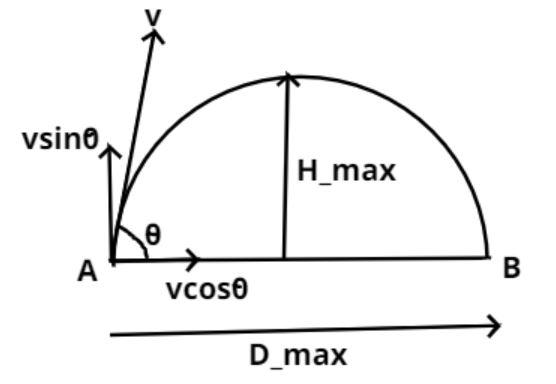
Derive the equation of projectile motion.
Answer
517.8k+ views
1 likes
Hint: In this question consider an object performing projectile motion and whose velocity is tangential to the path which it is taken. Take the two components of the velocity considering that object’s velocity is making an angle
Complete Step-by-Step solution:

Let an object be thrown with a velocity (v) from point A with an angle
So the velocity component along x-axis is given as =
And the velocity component along the y-axis is given as =
Now at time (T = 0) there is no displacement along the x and y-axis.
So initial distances are zero along the x and y-axis.
Now at time T = t, displacement
And the displacement
As the object is above the horizontal axis therefore acceleration works on the object downwards therefore a = - g = 9.8 m/
Now as we know that when the particle reaches its maximum height the velocity component of the y-axis should be zero.
Let the time required to reach the maximum height is
So from equation (2) substitute the values we have,
So this is the maximum time required to reach at the maximum height.
Now the total time of the projectile is twice of this time.
So total time of projectile or total time of flight to reach the ground is
=
Let the maximum height be
Now from third law of motion we have,
As final velocity becomes zero when particle reaches the maximum height and initial velocity is
Now substitute the values we have,
Now simplify it we have,
So this is the maximum height reached by the particle.
Let the maximum horizontal distance be
Now from equation (1) we have,
In this equation
So equations (3), (4) and (5) are the required equations of projectile motion.
So this is the required answer.
Note – A projectile is any object that once projected continues the motion under the influence of gravity without the interference of any external force. By definition only a projectile has only one force: the force of gravity. If an external force starts acting upon the object in between the projectile then it can’t continue the projectile as the path gets changed.
Complete Step-by-Step solution:

Let an object be thrown with a velocity (v) from point A with an angle
So the velocity component along x-axis is given as =
And the velocity component along the y-axis is given as =
Now at time (T = 0) there is no displacement along the x and y-axis.
So initial distances are zero along the x and y-axis.
Now at time T = t, displacement
And the displacement
As the object is above the horizontal axis therefore acceleration works on the object downwards therefore a = - g = 9.8 m/
Now as we know that when the particle reaches its maximum height the velocity component of the y-axis should be zero.
Let the time required to reach the maximum height is
So from equation (2) substitute the values we have,
So this is the maximum time required to reach at the maximum height.
Now the total time of the projectile is twice of this time.
So total time of projectile or total time of flight to reach the ground is
=
Let the maximum height be
Now from third law of motion we have,
As final velocity becomes zero when particle reaches the maximum height and initial velocity is
Now substitute the values we have,
Now simplify it we have,
So this is the maximum height reached by the particle.
Let the maximum horizontal distance be
Now from equation (1) we have,
In this equation
So equations (3), (4) and (5) are the required equations of projectile motion.
So this is the required answer.
Note – A projectile is any object that once projected continues the motion under the influence of gravity without the interference of any external force. By definition only a projectile has only one force: the force of gravity. If an external force starts acting upon the object in between the projectile then it can’t continue the projectile as the path gets changed.
Latest Vedantu courses for you
Grade 11 Science PCM | CBSE | SCHOOL | English
CBSE (2025-26)
School Full course for CBSE students
₹41,848 per year
Recently Updated Pages
Express the following as a fraction and simplify a class 7 maths CBSE

The length and width of a rectangle are in ratio of class 7 maths CBSE

The ratio of the income to the expenditure of a family class 7 maths CBSE

How do you write 025 million in scientific notatio class 7 maths CBSE

How do you convert 295 meters per second to kilometers class 7 maths CBSE

Write the following in Roman numerals 25819 class 7 maths CBSE

Trending doubts
Where did Netaji set up the INA headquarters A Yangon class 10 social studies CBSE

A boat goes 24 km upstream and 28 km downstream in class 10 maths CBSE

Why is there a time difference of about 5 hours between class 10 social science CBSE

The British separated Burma Myanmar from India in 1935 class 10 social science CBSE

The Equation xxx + 2 is Satisfied when x is Equal to Class 10 Maths

What are the public facilities provided by the government? Also explain each facility




